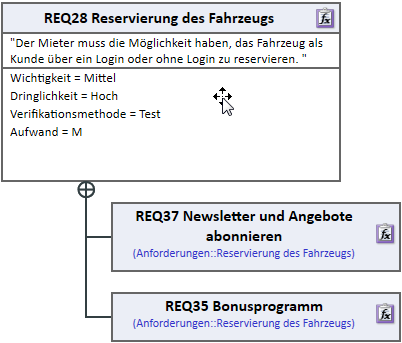A requirement diagram is a generic Systems Modeling Language (SysML) diagram for the graphical depiction (modeling) of requirements and their dependencies.
You can use the established MID modeling tool to create Requirement Diagrams.
Test the Innovator Enterprise Modeling Suite for free.
Definition
A requirement diagram depicts requirements of a system and their dependencies.
 The requirement diagram icon shows a diagram with a requirement icon.
The requirement diagram icon shows a diagram with a requirement icon.
Use
Requirement diagrams describe the requirements placed on your system, their properties and the dependencies between the requirements.
The Point of Contact, Stakeholders and Contents compartments can be shown for a requirement in a requirement diagram, in addition to the properties and stereotype properties. Maintenance can be set to Automatic for the Points of Contact and Stakeholders compartments. This automatic maintenance automatically adds the compartment entry to the diagram. Without automatic maintenance, the invalid compartments are merely removed. Maintenance is also carried out to the Stakeholders section if the opposite is stakeholder for property is modified. It is always alphabetically sorted.
Modeled contents and vocabulary used needs to be tailored towards the group of persons participating. A requirement diagram models a partial section of the real world. Only requirements and dependencies which are needed for describing the problem area are taken into consideration.
Requirement Diagram Elements
Nodes
The following model elements can be shown as nodes in requirment diagrams:
| Icon | Element | Description |
|---|---|---|

|
Requirement |
A requirement contains the description of the desired quality and capability that a system must have in order to fulfill a contract or comply with a standard, specification or other formally prescribed documents. Requirements can be nested. They have an outline number. The outline number constitutes a composed index of the requirements within their owners. The root of the hierarchy is reached when the owner has a different element type than "Requirement". |

|
Functional Requirement |
A functional requirement contains the description of a desired capability of a system to fulfill a contract or comply with a standard, specification, or other formally prescribed documents. |

|
Business Requirement |
A business requirement contains the description of the desired quality and capability that a system must have in order to meet a business objective. |

|
Performance Requirement |
A performance requirement contains the description of the desired performance that a system must render in order to fulfill a contract or comply with a standard, specification or other formally prescribed documents. |

|
Usability Requirement |
A usability requirement contains the description of the desired quality and capability that a system must have in order to meet standards regarding system usage by its users. |

|
Supportability Requirement |
A supportability requirement contains the description of the desired quality and capability that a system must have in order to fulfill a contract or comply with a standard, specification or other formally prescribed documents with regard to the supportability of the system. |

|
Reliability Requirement |
A reliability requirement contains the description of the desired quality and capability that a system must have in order to fulfill a contract or comply with a standard, specification or other formally prescribed documents with regard to the reliability of the system. |
Edges
Edges depict dependencies in requirement diagrams.
| Icon | Element | Description |
|---|---|---|

|
Dependency | A dependency is a directed relationship that states that the source element depends on the target element. |

|
Derive Requirement Relationship |
A derive requirement relationship is a dependency relationship that demonstrates that the element shows an abstraction of the linked element. |

|
Copy Relationship |
A copy is a dependency relationship that demonstrates that the element shows a copy of the linked element. |

|
Directed Relationship Edge | Adds an existing directed relationships edge to an element. |

|
Membership | Adds an existing membership edge to an element. |

